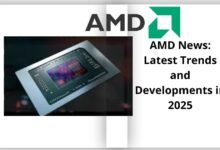AMD Share Price Surges After OpenAI Deal: How Technology is Rewriting the Chip War

AMD share price jumps after a groundbreaking partnership with OpenAI, reshaping the AI chip market and redefining the company’s technological destiny.
table of contents
The Turning Point: AMD’s Technological Bet Pays Off
For years, AMD (Advanced Micro Devices) has played the role of a challenger in the semiconductor industry — always close behind, but rarely ahead. That narrative may now be changing. The company’s recent strategic partnership with OpenAI, announced in early October 2025, has triggered a seismic reaction in both the tech and financial worlds.
The AMD share price soared by more than 25% within hours of the announcement, breaking through multiple resistance levels and setting new multi-year highs. But beyond the short-term market frenzy lies a much deeper story — one that intertwines technology, artificial intelligence infrastructure, and the evolving balance of power in the GPU war that has long been dominated by NVIDIA.
Perplexity Launches Comet AI Browser in India: A New Era of Agentic Browsing
AMD and OpenAI: The New Technological Alliance
The deal, valued at several billion dollars in potential GPU supply, positions AMD as a core supplier of Instinct MI450 AI chips to OpenAI over the coming years. According to insider reports, OpenAI has also secured an option to acquire up to 10% of AMD’s shares, should performance and delivery milestones be achieved.
This move signals more than just a supply agreement — it’s a vote of confidence from the world’s most influential AI company. For OpenAI, this partnership means diversifying away from a single vendor ecosystem. For AMD, it’s the long-awaited validation of its AI hardware roadmap — proof that its investments in high-performance computing (HPC) and data center GPUs are beginning to pay off.
From a technical standpoint, AMD’s Instinct line of accelerators has always lagged slightly behind NVIDIA’s Hopper and Blackwell architectures in raw benchmark performance. However, AMD has made critical strides in efficiency, scalability, and price-performance ratios. With OpenAI’s massive demand for AI compute — especially for GPT and multi-modal model training — AMD now has the chance to demonstrate real-world performance at scale.
AMD Share Price and the Tech Ripple Effect
The financial markets responded immediately. AMD’s stock jumped above $225, from a previous close near $180, reaching its highest point since early 2024. Trading volume spiked to over 240 million shares, signaling strong institutional participation and speculative momentum.
What’s more telling, however, is how the market interpreted the news. Analysts across Barclays, Bank of America, and Morgan Stanley upgraded AMD’s outlook to “Buy” or “Strong Buy,” citing an expanded total addressable market in AI infrastructure — a sector expected to surpass $400 billion by 2030.
The AMD share price, now trading well above historical averages, reflects not just optimism but confidence in a strategic pivot: from being a CPU and GPU manufacturer to becoming a major player in the AI silicon ecosystem.
This transformation aligns AMD with the global technological trend toward AI sovereignty — where nations, corporations, and startups race to build proprietary AI hardware stacks independent of NVIDIA’s dominant ecosystem.
The AI Chip Race: AMD’s Technological Edge
AMD’s competitive edge lies in architectural flexibility and cost efficiency. Its ROCm (Radeon Open Compute) software stack, once seen as a weakness, is now maturing rapidly. Recent updates have brought greater compatibility with frameworks like PyTorch, TensorFlow, and JAX, closing the gap between AMD’s GPUs and NVIDIA’s CUDA ecosystem.
The OpenAI collaboration is expected to accelerate this process further. Engineers from both companies are reportedly co-developing optimizations for large-scale training tasks, ensuring that AMD’s hardware can run OpenAI’s most advanced models seamlessly.
In addition, AMD’s chiplet design philosophy gives it a modular advantage — enabling faster iteration, lower production costs, and greater thermal efficiency. This could prove crucial in the upcoming generation of exascale AI data centers, where power efficiency is becoming as important as raw computational throughput.
If AMD manages to deliver consistent yields of the MI450 and its successor MI500 series, it could disrupt NVIDIA’s near-monopoly on AI training chips, especially in hyperscale and enterprise markets.
Challenges Behind the Headlines
Despite the euphoria, not everything is risk-free. There are several challenges AMD must navigate carefully:
- Execution Risk – Delivering tens of thousands of high-end GPUs to OpenAI on time requires near-perfect supply chain coordination, especially with ongoing global semiconductor constraints.
- Software Ecosystem Maturity – Although ROCm is improving, CUDA still dominates AI workflows. Convincing developers and data centers to shift workloads will require significant investment in compatibility and developer support.
- Competitive Counterattack – NVIDIA is unlikely to stand idle. Industry insiders suggest that the company is accelerating its next-gen “Blackwell Ultra” launch, aimed at outclassing AMD’s MI450.
- Market Volatility – The AMD share price is now trading at high valuation multiples, meaning any production delay or missed delivery milestone could trigger a sharp correction.
These factors highlight that while AMD’s OpenAI partnership represents a turning point, it also introduces new expectations that must be met or exceeded to sustain the current momentum.
The Future: A New Chapter in AI Infrastructure
Looking ahead, the AMD–OpenAI partnership may mark the beginning of a multi-vendor AI hardware era, ending years of NVIDIA’s dominance. For OpenAI, this diversification ensures resilience and scalability. For AMD, it’s a direct entry into the highest-value layer of the AI stack — the compute backbone that powers the world’s most advanced models.
If AMD successfully executes on its delivery roadmap, the company could unlock a multi-decade growth trajectory — much like NVIDIA did after the AI boom of 2020–2023.
The immediate implication for investors is clear: AMD is no longer just a semiconductor company. It’s positioning itself as an AI infrastructure enabler, sitting at the intersection of technology innovation and financial opportunity.
Conclusion
The surge in AMD share price following its OpenAI deal is more than a temporary rally — it’s a reflection of technological validation. AMD has proven that it can compete in the most complex and lucrative domain of modern computing: AI acceleration.
However, the company now faces its biggest test — delivering on the promise. Execution, production efficiency, and ecosystem development will determine whether this partnership becomes AMD’s defining moment or just another spike in the volatile world of tech stocks.
For now, the outlook remains bullish. With OpenAI’s vote of confidence and a rapidly evolving technological roadmap, AMD stands on the brink of a new era — one where its name might finally stand beside NVIDIA not as a challenger, but as a true equal.
FAQs
1. Why did AMD share price rise so sharply in October 2025?
Because AMD announced a major partnership with OpenAI to supply advanced AI chips (Instinct MI450), triggering investor optimism and large-scale buying activity.
2. How does this deal affect NVIDIA’s market position?
It challenges NVIDIA’s near-monopoly in AI hardware by giving OpenAI — one of its biggest customers — a viable alternative supplier in AMD.
3. Is AMD’s technology ready to compete with NVIDIA’s CUDA ecosystem?
Not fully yet, but AMD’s ROCm platform is closing the gap quickly, and collaboration with OpenAI could accelerate compatibility and performance.
4. Could the AMD share price experience a correction?
Yes. Given the current valuation and high expectations, any production delays or missed milestones could lead to a short-term pullback.
5. What’s the long-term outlook for AMD in the AI sector?
If AMD executes successfully, it could establish itself as a key AI infrastructure player, potentially doubling or tripling its market cap over the next several years.
Discover more from Feenanoor
Subscribe to get the latest posts sent to your email.









